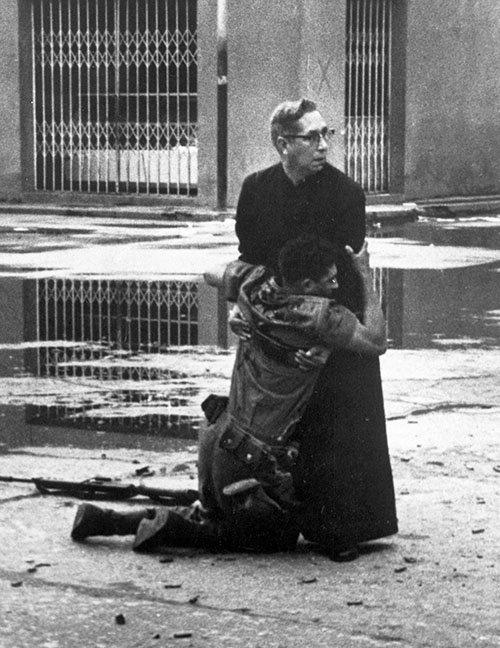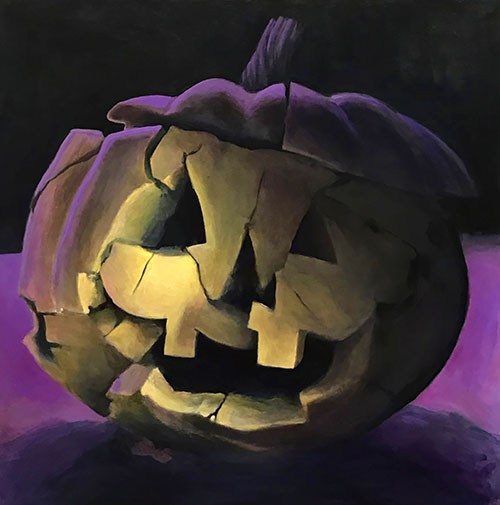Can Art Affect Social Change?
This is difficult to admit, especially here. But I'm skeptical about whether art really works as an agent of social change. The consensus is mostly to the contrary, so it is rare that I give voice to my doubts. I am not opposing art as an agent of social change, but questioning its effective usage. Eliminating racism, sexism, agism, toxic human behavior, and environmental threats are undeniably supreme goals we should all move towards. But can we do it with a sculpture? Or have we just not found the right way?
The power of a compelling image is not the question. There are countless paintings and photographs that pierce my conscience and expose my cowardice. Photographs haunt me the most and turn my heart to silently search itself in moments of solitude. An example is the Pulitzer Prize-winning photograph "Aid from the Padre," by Héctor Rondón Lovera, 1962. In the image a dying soldier clings to a priest, both are standing in the street. The priest braved gunfire to attend to the soldier's last rights. It is too late for me to affect that world-instant. But I can honor its worth by allowing it to work on me. Is my bravery equal to the soldier's? Is my compassion and faith equal to the priest's? Is my courage comparable to Lovera's? Am I brave enough in a daily situation not as life-threatening to speak truth, openly challenge ignorance, or act selflessly?

Lovera's image is implicitly about a historic power struggle in Venezuela. But even sixty years after it was taken, the photo does not require historical knowledge to challenge the quality of my soul. Raw humanity on display makes me curious about historical particulars, not the other way around. With all mortal respect to the priest, the soldier, and the photographer and their life-and-death situation, art with a social mission rarely comes close to what this image does. In comparison, socially conscious work feels like a rubber stage knife, or worse, a painting of a knife.
Maybe part of the problem becomes visible examining the recent popularity of art that addresses the environment. Community groups, non-profits, and independent artists have been engaged making work that recycles refuse or beach trash. It is obviously aligned to affect a change. The weakness of this work, in my opinion, is that it relies on the public endorsement of its gesture more than the creative outcome. Using beach trash, or any cast-off material is brilliant. The resource is endless (one day, hopefully, that will change). Removing it is obviously beneficial. But artistic vision appears to end there. What is typically done with the haul is so pedantic it nearly amounts to relocating a trash heap from one place to another. That may seem harsh. But aesthetic experience has been a large component of art since before there was an environmental crisis. Aesthetics is not a useless Classical idea. We all know, beauty does not equal truth. But creating a positive viewer experience is a great way of communicating the value you want to express. There are so many resources online that show methods to reform single-use plastics into ingenious and useful tools. The naked brilliance of methods for joining, melting, and forming plastics into considered and interesting forms motivates me to discover my own adaptations. It motivates me far more than the results of most environmental art. Not just because it can be functional. Invention does not entice me to compliance with a lesson or ask me to lie to myself about an object that is sub-par. Invention awakens inventiveness, inquiry, and exploration. You can say I have a weak moral center, but I will give one hundred percent of my loyalty if you inspire me, instead of make me feel coerced.
That may be what is missing in work that tries to affect social change. Lovera's photo lets me do the slow work. It merely needs to be. Current events may feel urgent, but applying pressure risks a change of social behavior and not a change of heart. Indicting the viewer, using "gotcha" tactics, perpetuating violence, or unearthing past evils result in objects too easy to dismiss, doing grievous disservice to intent. I'm not suggesting socially conscious art should be "beautiful." It is horrid to suggest human suffering be aestheticized. "Aid from the Padre" does not work because of aesthetic merit. The human act it documented is its beauty. To think of Guernica as an anti-war message almost renders it worthless. It is not beautiful because it depicts something ugly. But Guernica contributes nothing to an already established moral argument. War is bad. Yet, when I consider it the work of a grieving person, that needed an eleven feet high and twenty-seven feet long painting to begin processing loss, I feel connection. Guernica is not a message, first, but a human expression.

It's easy to think that "message" is a work of art's most important facet. I think it is a commonly held opinion of all who begin to explore the art world. When encountering a work that is incomprehensibly alien and completely inaccessible, the first qualifier to legitimize such work is that it "has a message." "Content" in academic jargon. Later on, however, there are many reasons artists, viewers, collectors, and curators come to reevaluate the reliance on content as the only universal justifier. My reevaluation occurred when the need for a message, not just any message, the right one, the perfect one (the one that never arrives) shut down my creative process. By shut down, I mean broke it. Recovery came through learning to recognize and follow my impulses, not my thoughts. Impulses led me to do things. This felt terrifying and wrong, the stuff of reputation-destroying mistakes. However, as I yielded to impulses, through the doing, insights would come. These insights were unexpected, but welcomed with relief and gratitude. Something creative was still alive in me despite myself. The insights materialized in thought-form, and were reflections on what I had physically done. Apparition is an example and product of that experience. The reconstructed ornamental pumpkin fills the whole painting. By extension, the painting becomes a Jack-O-Lantern, a poetically disembodied head. As an object, as "Form," this painting/head will remain fixed and age with time. But how it will be understood, the "Content," what it "means," will alter from person to person, from year to year, from current-event epoch to current-event epoch. The "Content" is something intangible but connected, a metaphor of the supernatural. Similar to color as an example of something that only exists within our experience. Possibilities for content can be justified by citing form as supporting evidence but not found "within" form. Content happens when one human consciousness encounters something another human consciousness made (not always art) then searches within itself for a way to identify with the gesture. If that search is foreclosed by giving away the answer, or clever delivery, the message will undoubtedly be communicated. But that is all that will be delivered. It will be delivered at the expense of any meaningful empathetic effort on the part of the viewer.
This is what feels unsuccessful about socially conscious art. It starts as message, a commercial, and remains a message. Like environmental art, it does not rely on outcome, but the endorsement of a consensus. The message may be implicitly well-intended, but the art does the work for the viewer. When artwork is an authentic expression of personal experience and not a sermon, it already is a message. It doesn't need legitimacy much less a gimmick to make it work. The most subversive thing about art is that it can still exist. When I think of Kehinde Wiley, for example, I don't need to know what his work means. What it means, for me, is the experience that delivers visual pleasure. To look at a Wiley is to see black and brown men the way he does. He shares his admiration and affection with us, it's unavoidable. That is what makes his work "dangerous." There are no assumptions about my intelligence as a viewer. I'm being invited to enjoy what he enjoys with no apology and without being impolite. It's incidental that it is men of color, because that is personal to Wiley. It is in his expression that we connect, and I am expanded. There are other artists who change me (Lorna Simpson, Laylah Ali, Collier Schor, Tony Feher, Alice Neel, Carmen Lomas Garza, for example). They share their world and their vision without an assault. They are dangerous because they do not tell, they show.
Born in Mobile, Alabama, Hill received his B.F.A. from the University of South Alabama in painting and drawing. Originally majoring in music, then philosophy, Hill decided to major in art immediately after his first drawing class. Following his undergraduate degree, he attended the University of Tennessee, in Knoxville, accepting a graduate teaching assistantship, and earned his M.F.A. Corpus Christi became his home in 2000. Since then, Hill has worked as a substitute teacher, museum preparator, picture framer and, in 2011, became an adjunct professor at Del Mar Community College. For a period of time, he abandoned artmaking but has worked to reconnect to those impulses. Currently, he models his paintings from small constructions or tableaus that he assembles. Hill works as an Assistant Professor of Art at Texas A&M University Corpus Christi. Teaching is his calling. Serving his students brings him satisfaction second only to his artistic practice.